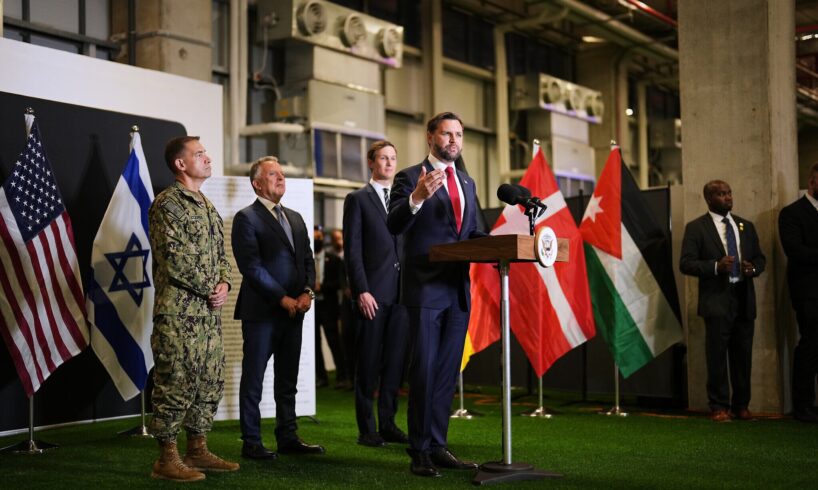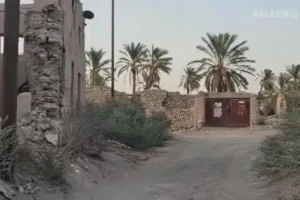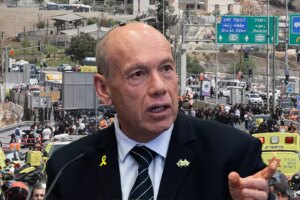
Israel is playing a secondary role to the US at the Civil-Military Coordination Center (CMCC) in Kiryat Gat, where the Gaza ceasefire is being monitored by at least a dozen nations, an Israeli official told The Times of Israel on Friday.
The compound in southern Israel is intended as a hub for the International Stabilization Force (ISF) set to take the reins of Gaza as part of US President Donald Trump’s comprehensive ceasefire plan, which the US is seeking to enshrine into international law via a UN Security Council vote.
According to the official who spoke with The Times of Israel, the US has been the prime decision-maker at the CMCC, including on issues pertaining to the delivery of aid to Gaza, where Israel has accused Hamas of looting aid convoys and placed restrictions on the shipments.
Israel’s Coordinator of Government Activities in the Territories (COGAT), the Defense Ministry agency that oversaw aid delivery to the devastated enclave throughout the war, has been relegated to more of a contractor role at the CMCC, the official added, confirming details of a Friday Washington Post report.
The CMCC was established on October 17 as a “main coordination hub” to “support stabilization efforts” in Gaza, following a declaration signed by Trump and his Turkish, Qatari and Egyptian counterparts in Sharm el Sheikh on October 13, according to the US military’s Central Command (CENTCOM).
Get The Times of Israel’s Daily Edition
by email and never miss our top stories
By signing up, you agree to the terms
Along with Israel and the US, countries that have sent troops to the compound include Jordan, the UK, Germany, Denmark, Canada, Australia, France, Spain and the United Arab Emirates. Despite the presence of the foreign soldiers, the CMCC’s composition, role, chain of command, legal status and other issues are not yet locked down.
It is also still unclear which countries will agree to send troops into Gaza as part of the ISF, which Trump on Friday said would deploy “very soon.” Under Trump’s plan — the entirety of which has been submitted to the UN Security Council for approval — the stabilization force will take over Gaza as the IDF completes its withdrawal from there.
Humanitarian aid enters Gaza via the Kerem Shalom Crossing with Israel, in Khan Younis, in the southern Gaza Strip, November 2, 2025. (Abed Rahim Khatib/Flash90)
In the meantime, Hamas has been reasserting control over its side of the ceasefire line that the IDF withdrew to on October 10, a day after Israel and Hamas signed a truce-hostage agreement based on the initial phase of Trump’s comprehensive plan.
Under the agreement, Hamas released the last 20 living hostages on October 13, and returned the remains of 23 deceased hostages. Trump is planning to send a US Air Force plane to pick up the living hostages and their families and visit him at the White House in the next two weeks, according to a Channel 12 report confirmed to The Times of Israel on Friday by a US official.
The remains of five deceased hostages remain in Gaza, including a soldier killed in the 2014 Gaza war, and four people killed in the Hamas onslaught of October 7, 2023, which sparked the current war.
The next phases of Trump’s ceasefire plan include calls to disarm Hamas, demilitarize Gaza, deploy the ISF and establish an apolitical civilian administration of Palestinian technocrats overseen by a so-called “Board of Peace” led by Trump.
US President Donald Trump speaks during a meeting with Hungarian Prime Minister Viktor Orban in the Cabinet Room of the White House in Washington on November 7, 2025. (SAUL LOEB / AFP)
Asked on Friday when the ISF will be on the ground in Gaza, Trump said, “It’s going to be very soon.”
“Gaza is working out very well, and you haven’t been hearing too much about problems,” Trump told reporters at the White House.
Trump also reiterated his claim that many countries have been volunteering to contribute troops to the force to take on Hamas if necessary. The claim contradicted what Arab diplomats are saying behind closed doors — that they don’t want to send their troops into Gaza if it means clashing with Hamas, which is publicly refusing to disarm.
US official: ISF to require some 20,000 troops, 2-year mandate
Speaking after Trump, US Secretary of State Marco Rubio said Washington is working to pass a Security Council resolution in the coming weeks to provide the legal framework for countries to join the ISF. Rubio noted that the countries volunteering to contribute troops “need this UN mandate in order to be able to do it.”
A senior US official said Washington was seeking a two-year mandate for the ISF and Board of Peace at the UN. According to the official, the ISF was shaping up to be around 20,000 troops. While the Trump administration has ruled out sending US soldiers into the Gaza Strip, it has been speaking to Indonesia, the United Arab Emirates, Egypt, Qatar, Turkey and Azerbaijan to contribute.
“We’ve been in steady contact with the potential troop contributors, and what they need in terms of a mandate, what type of language they need,” said the official. “Almost all of the countries are looking to have some type of international mandate. The preferred is the UN.”
A general view shows the United Nations Security Council meeting on the situation in Gaza, at UN headquarters in New York on September 18, 2025. (Angela Weiss / AFP)
The official said he was unaware if Israel had ruled out any specific countries from contributing troops to the ISF, but added: “We’re in constant conversations with them.” Israel said last month it would not accept Turkish armed forces in Gaza under the US peace plan.
A copy of the draft Security Council resolution, which was obtained and verified by The Times of Israel, included Trump’s entire 20-point Gaza ceasefire plan. The annex was added to the draft over the last 48 hours, a European diplomat told The Times of Israel early Saturday.
The US has held consultations on the resolution this week with other Security Council members, along with the delegations of Egypt, Qatar, Turkey, Saudi Arabia, the United Arab Emirates and the Palestine Liberation Organization, which dominates the Palestinian Authority, Hamas’s West Bank-based rival. However, Washington hasn’t been open to making any significant changes, the diplomat said, confirming reporting in The New York Times.
One of the few changes that was made over the past several days pertained to the handover of Gaza’s administration from the US-envisioned Board of Peace to the Palestinian Authority.
Initial versions of the US-sponsored resolution said the transfer will not take place until the PA “has satisfactorily completed its reform program, the satisfaction of which shall be acceptable” to the Board of Peace. The latest version obtained by The Times of Israel says the handover will occur when the PA “has satisfactorily completed its reform program as outlined in” Trump’s plan.
US President Donald Trump greets Palestinian Authority President Mahmoud Abbas during a summit on Gaza in the Egyptian resort town of Sharm el-Sheikh on October 13, 2025. (Evan Vucci / POOL / AFP)
However, the September 29 plan gave little detail about its desired PA reforms, referring only to “various proposals, including President Trump’s peace plan in 2020 and the Saudi-French proposal” from earlier this year.
The 2020 plan doesn’t include an explicit reform program but does have a long list of tasks that the PA is required to meet in order to be granted a state, including recognizing Israel as a Jewish state — something the PA has long refused to do, arguing that its recognition of Israel as part of the 1993 Oslo Accords is sufficient.
The Saudi-French plan’s reform criteria included the abolition of the PA’s so-called pay-to-slay stipends to Palestinian prisoners; removal of incitement to terrorism in the PA school curriculum; and holding elections, which the PA has not done since 2006.
PA President Mahmoud Abbas signed legislation in February scrapping Ramallah’s old welfare program that included payments to prisoners based on the length of their sentence, and has pledged to hold elections within a year of the war ending.
He also said in September that the PA is planning elections, drafting an interim constitution and developing educational curricula in accordance with UNESCO standards. The reform will be completed within two years, he said.
Lazar Berman contributed to this report.





